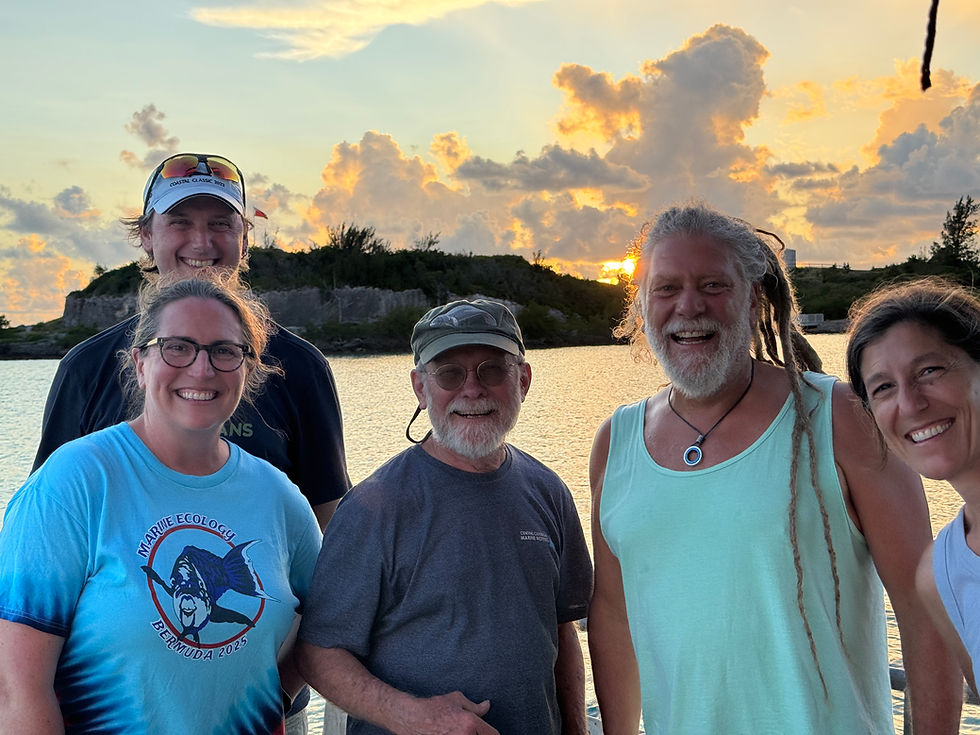Bermuda Day 5 - July 10th
- Lucy Badger
- Jul 11
- 3 min read
By Lucy, Joah, and Embry
We started the day with a snorkel off the boat at Taunton Wreck. A large cargo ship hit the reef in 1920, and since then, it has been covered in coral and plant growth. The wreck was super close to the surface, with the top being 6-10 feet under the water, to the rest broken on the sea floor. Some of us dove down to the bottom to look under the boat's crevices. There wasn’t a lot of diversity of fish species around the ship, but we did see a lot of sergeant majors and some fire coral! We swam to a nearby shallow reef wall and saw a barracuda.
Around 12:30 this afternoon, our class met up with our cave expert Claire and boarded the bus to the Walsingham Nature Reserve. After a 20 minute bus ride, the students gathered under the shade of the Bermuda Cedar. After a brief overview, we began our walk to the Mangrove Bay. We learned about the importance of mangroves to Bermuda’s aquatic and land ecosystems, and we then made our way to the first cave. The cave sported major stalactites hanging from the ceiling and walls, made of limestone and continuously growing. Our second stop was another cave with a slippery walk down to the cave opening, where the water was strikingly clear. We went to our first swimming spot shortly after. Shoes required, sunscreen applied, and the heat nearly unbearable, more than half the class participated in jumping off the cliff into the inviting Bermuda water. Only ten minutes later, we were on our way again on a fifteen minute walk to the cave diving spot. People must have got the memo of the beautiful day, because the nature reserve ended up being pretty busy! While we waited for the cave diving spot to open up we took a short climb to a dry cave, where the ceiling was so low that a crouch was required. After the crowd cleared, we suited up in our masks and snorkels, no fins this time due to the possibility of kicking up heavy sediment. Entering the cave, some people jumped in right away while others scrambled across the cave floor. With a depth of 25 feet, and minimal natural lighting, we relied on our underwater lights to lead the way. After a quick dip, we dried off and headed back to the bus in order to make it back in time for the Boat Tour.
The boat tour was of the Atlantic Explorer, an R/V NOAA vessel docked at BIOS. The furthest north it has gone is Nova Scotia, and the furthest south is Puerto Rico. We went from the bottom of the ship, the deck, the equipment, and the research labs, all the way to the top, which held navigation, immersion suits, emergency vests, and a beautiful view.
After a long day traveling around the island, the class reconvened at 8pm to jump on the bus for a quick ride to Coopers Island for a sunset snorkel. As we arrived at the beach, the sun was setting over the ocean, with a bright orange moon sitting above the rocks out in the water. After the whole class entered the water, we departed as a large group towards the rocks in the distance. The longer the swim went on, the darker and darker it got, with more and more students turning on their bright underwater lights and the beach dipping farther and farther into the dark. In the dark ocean, lots of creatures come out of hiding, as a class we spotted octopus, lobsters, squirrel fish, and more. Well, after the sun had set, and the beach was completely gone from our view, we turned around and headed back towards land. Even with water filled with sand and plankton, the class had a successful first night snorkel, and got back in time to get some work done before another big day tomorrow.
























Comments